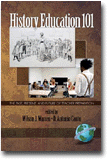
History Education 101
The Past, Present, and Future of Teacher Preparation
Edited by:
Wilson J. Warren, Western Michigan University
D. Antonio Cantu, Indiana University Kokomo
Published 2008
Historians and teacher educators nationwide are now engaged in discussions about the importance of history teacher preparation. Interest within the history profession about the teaching of K-12 history has increased significantly during the past two decades, particularly since the controversy over the National Standards for History’s publication. This attention is evident not only in the historical professions’ various publications, but also in the federal government’s multi-million dollar Teaching American History Program and the No Child Left Behind Act. Professional historians are increasingly committed to improving the teaching of history at the K-12 level through many forms of collaboration.
History Education 101’s thirteen essays are organized into three sections: context, practice, and new directions. The essays’ contributors, tenured faculty who teach history teaching methods courses in colleges and universities throughout the United States, focus on how history education has, is, and will be taught to new K-12 teachers throughout the United States. Perhaps more than ever, it is critical for Americans to understand the role of higher education in the preparation of future middle and high school history teachers. This book provides important insights for academics in history and education departments as well as other individuals who are concerned with the status and improvement of history teaching in the schools, particularly current and future elementary and secondary teachers and administrators.
CONTENTS
Foreword: Surveying the History Education Landscape, Wilson J. Warren and D. Antonio Cantu. Acknowledgments. PART I: Context. Paradoxical Paradigms: A Comparative Study of Discipline-Based and Education-Based History Teacher Education, D. Antonio Cantu. Somewhere Between a Dark and Golden Age: The American Historical Association and K–12 History Education, 1950–1970, Russell B. Olwell. The Evolution of a History-Centered Teaching Program: Western Michigan University’s Preparation of Secondary Teachers, Wilson J. Warren. Swing of the Pendulum: From Social Studies Education to History Education at Illinois State University, Frederick D. Drake. In Search of a Home...Department: Where Does Social Studies Education Belong? Ashley Lucas. PART II: Practice. Continuity and Constraint: Case Studies of Becoming a Teacher of History in England and the United States, David Hicks. Historians and History Teachers: An Academic’s Approach to Training High School Teachers, James Wolfinger. The Five Cs of History: Putting the Elements of Historical Thinking into Practice in Teacher Education, Flannery Burke and Thomas Andrews. Inquiry, Controversy, and Ambiguous Texts: Learning to Teach for Historical Thinking, Daisy Martin and Chauncey Monte-Sano. The Professional Year Model: Preparing Preservice History/Social Studies Teachers to Teach with Technology, Gina Hogue. PART III: New Directions. Scholar-Teachers and Teacher-Scholars: The History Professor’s Role in the Professional Development of History Teachers, Fritz Fischer. No Preservice Teacher Left Behind: Process and Content in the Age of Standards, Richard Cooley. What Teachers Think: How Have Efforts of Accountability Affected Classroom History Teachers? Sean O’Neill. Afterword: Attempting to Put the Horse before the Cart, Gary B.
Nash. About the Contributors.
-
Paperback978-1-59311-860-0
Web price: $45.04 (Reg. 52.99)
-
Hardcover978-1-59311-861-7
Web price: $80.74 (Reg. 94.99)
- eBook9781607528777

- EDU037000 - EDUCATION: Research
- EDU016000 - EDUCATION: History
- HIS035000 - HISTORY: Study and Teaching
-
 (Re)Envisioning Social Studies Education Research
Current Epistemological and Methodological Expansions, Deconstructions, and Creations
(Re)Envisioning Social Studies Education Research
Current Epistemological and Methodological Expansions, Deconstructions, and Creations
-
 Distance Learning
Volume 20 #3
Distance Learning
Volume 20 #3
-
 Distance Learning
Volume 20 #4
Distance Learning
Volume 20 #4
-
 Faculty Development
Achieving Change Through Action Research
Faculty Development
Achieving Change Through Action Research
-
 History Education and Historical Inquiry
History Education and Historical Inquiry
-
 Qualitative Research With Diverse and Underserved Communities
Qualitative Research With Diverse and Underserved Communities
-
 Quarterly Review of Distance Education
Volume 24 #1
Quarterly Review of Distance Education
Volume 24 #1

